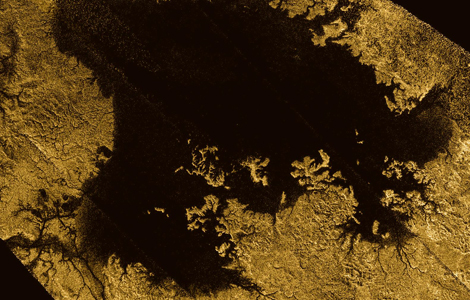Ingredient of Plastic Found on Titan
Cassini’s latest find hints at more exciting discoveries to come
An infrared spectrometer on the Cassini spacecraft now circling Saturn has detected for the first time the chemical compound propylene (also called propene) on a world beyond Earth.
It was suspected for a while that this compound would be present in the organic-rich atmosphere of Saturn’s large moon Titan, but it was difficult to detect, being crowded out by related chemical compounds with much stronger signals, according to Michael Flasar of NASA’s Goddard Space Flight Center, principal investigator of the CIRS instrument that made the detection. Propylene is used in industrial processing on Earth as a building block to form polymerized propylene, or polypropylene—the basic ingredient of plastics used in everything from food containers to auto parts.
The discovery begs the question of what other intriguing finds await us on this exotic moon. Titan is the only moon known to have a significant atmosphere—denser even than our own, and thick enough that airplanes and helicopters have been proposed for exploring there. The air would not be breathable by humans, as it consists mostly of nitrogen, methane and trace amounts of various organic compounds. But that composition is very similar to what we believe was in our own atmosphere long ago, when life originated. Could life have started on Titan as well? If not, how far could the chemistry advance toward life in such a place?
Titan is also the only other body in our solar system with stable liquids on its surface—not water, but a mixture of ethane and methane, with a pinch of nitrogen. Ask any origin-of-life researcher, and they’ll tell you that the best way to achieve complex chemistry is to use hydrocarbons as a solvent (to dissolve larger compounds), not water.
Several years ago a National Academy of Sciences study panel concluded that “the environment of Titan meets the absolute requirements for life, which include thermodynamic disequilibrium, abundant carbon-containing molecules and heteroatoms (atoms other than carbon and hydrogen), and a fluid environment…” The panel report further stated that “this makes inescapable the conclusion that if life is an intrinsic property of chemical reactivity, life should exist on Titan.”
Any life on Saturn’s moon would have to be pretty exotic, however, and would require energetic reactions for metabolism much more powerful than anything seen on Earth in order to overcome the extremely cold surface conditions. Because Titan life would be so different from terrestrial life, we would surely have to postulate a separate origin. This led Bob Shapiro and me to suggest several years ago that Titan should have the highest priority for space missions focused on astrobiology. Titan life may not necessarily resemble boulder-like slugs, but it’s certainly bound to surprise us if we find it.
/https://tf-cmsv2-smithsonianmag-media.s3.amazonaws.com/accounts/headshot/Dirk-Schulze-Makuch-headshot.jpg)

/https://tf-cmsv2-smithsonianmag-media.s3.amazonaws.com/accounts/headshot/Dirk-Schulze-Makuch-headshot.jpg)